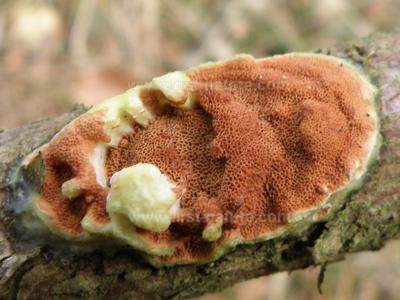Trees Birds Mammals Fish Amphibians Reptiles
Wild Algarve
Bookshop
Dichomitus campestris (Quél.) Domanski & Orlicz - Hazel Porecrust
Phylum: Basidiomycota - Class: Agaricomycetes - Order: Polyporales (insertae sedis) - Family: Polyporaceae
Distribution - Taxonomic History - Etymology - Identification - Reference Sources

Like so many of the polypores, this inedible crust fungus causes white rot of fallen branches of hardwood trees, and in particular Beech.
Distribution
Rarely seen in Britain or Ireland but an occasional find in northern Scotland, this attractive species occurs also on mainland Europe, from northern Scandinavia to southern Portugal, but it seems to be either rare or at least uncommon throughout this range.
Taxonomic history
In 1872 French mycologist Lucien Quélet described this polypore and gave it the binomial scientific name Trametes campestris. Its currently accepted scientific name dates from 1966, when Polish mycologists Stanislaw Domański and A. Orlicz transferred this species to the genus Dichomitus, a new genus that had been set up in the previous year by British mycologist Derrek Agutter Reid (1927 - 2006).
Synonyms of Dichomitus campestris include Trametes campestris Quél., and Coriolellus campestris (Quél.) Bondartsev.
Etymology
The specific epithet campestris means 'of fields', which seems an very odd choice, because this resupinate polypore cannot live without trees!
Identification guide
| |
Fruitbody
Nearly always a resupinate crust, but occasionally forming brackets. In resupinate form roughly circular or oval, up to 6cm across and projecting 1 to 3cm from substrate.
The circular or elongated tubes are spaced at 1 to 2 per mm and often irregularly spaced, terminated in creamy yellow to brown pores. Colour is an unreliable guide to identification of this particular fungus, however, because its fertile (outer) surface ranges from cream through yellow to a reddish brown, and when old the fruitbodies turn dark brown. |
| |
Spores
Elongated-ellipsoidal, smooth, 9-12 x 3.5-4.5; inamyloid.
Spore print
White. |
Odour/taste |
Not significant. |
Habitat & Ecological role |
Saprobic on dead broadleaf trunks and fallen branches, particularly of oaks. |
Season |
Usually annual, releasing spores in late summer and autumn. |
Reference Sources
Fascinated by Fungi, 2nd Edition, Pat O'Reilly 2016, reprinted by Coch-y-bonddu Books in 2022.
Dictionary of the Fungi; Paul M. Kirk, Paul F. Cannon, David W. Minter and J. A. Stalpers; CABI, 2008
Taxonomic history and synonym information on these pages is drawn from many sources but in particular from the British Mycological Society's GB Checklist of Fungi.
Top of page...
Fascinated by Fungi. Back by popular demand, Pat O'Reilly's best-selling 450-page hardback book is available now. The latest second edition was republished with a sparkling new cover design in September 2022 by Coch-y-Bonddu Books. Full details and copies are available from the publisher's online bookshop...